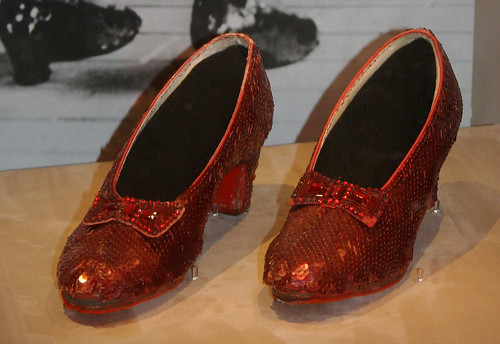Last night was the opening of The Wizard of Oz at my alma mater, California College of the Arts. Like always at the start of the semester, it was a full house, and the subject matter was well-suited to Wattis Director Jens Hoffmann's theatrical approach. The path of exhibition, which juxtaposed works by several notable international artists with ephemera from the titular novel and 1939 film, followed a narrative arc loosely based on that of the source material.
The show opens with multiple beginnings. The American Midwest, where the story begins, is represented here by Walker Evans' powerful photographs of threadbare farm houses, which date to roughly the same time as the MGM film starring the teenaged Judy Garland. A large wall installation by Donald Urquhart chronicles thehistory and the dark side of the film's creation in a style derived from cheery children's book illustrations. Between these is a first edition of L. Frank Baum's novel, accompanied by reprints of early reviews, representing the start of a long cultural engagement with the book.
Works such as Clare Rojas' drawings of women playing in a field of poppies, Evan Holloway's ax poised to chop, or Felix Gonzalez-Torres' images of birds flying through cloudy skies, can be read literally within the context of the story. Other works such as Bruce Conner's film Valse Triste have more subtle connections to the theme. Rivane Neuenschwander's installation Eu desejo o su desejo (I wish your wish) casts gallery visitors as Dorothy and her entourage, wishing for respite from the difficult journey ahead. Film originals include a first-run print, a Gramophone playing a recording of "Somewhere Over the Rainbow" and a pair of genuine Ruby Slippers.
The culminating work in the show is Steve McQueen's Once Upon a Time, in which images collected by NASA as indicators of human society and sent into space for alien consumption have been strung together and accompanied by a soundtrack of people speaking in tongues. The effect is wonderfully evocative of the Great and Terrible Oz - both ridiculous and full of hubris. Though traces of those characteristics can be found throughout the show, the negatives are outweighed by the strong use of space to describe a narrative, the visual interest of art mixed with cultural artifacts, and the iconoclastic takes of several artists on the literary source material.
The show runs through December 13.
skip to main |
skip to sidebar

Ruminations on art, life, politics, world events and anything else that comes to mind. May also contain traces of the following: animation, comics, industrial design, weird foreign films, punk/postpunk/industrial and experimental music, popular culture and economic/social critique. Made in a factory that also processes nuts.
Links
About Me

- Anuradha
- I am a curator and writer based in the San Francisco Bay Area. I've curated exhibitions for Craft and Folk Art Museum in LA, Mills College Art Museum in Oakland, DeYoung Museum Artist Studio in San Francisco, and numerous Bay Area non-profits and galleries. I am a Lecturer in Art Practice at San Jose State University and UC Berkeley, and in Art History at College of Marin. I'm #Hashtags editor for DAILY SERVING, and my writing has appeared in Artillery, Art Practical, Afterimage, LEONARDO, and OPEN SPACE: The SFMOMA Blog, as well as in books and catalogues on contemporary American artists including Sonya Rapoport and Chitra Ganesh. From 2009-2013, I was Curator at the Worth Ryder Art Gallery in the UC Berkeley Department of Art Practice. I earned an MA in Curatorial Practice from California College of the Arts, and a BS in Studio Art from New York University.




No comments:
Post a Comment